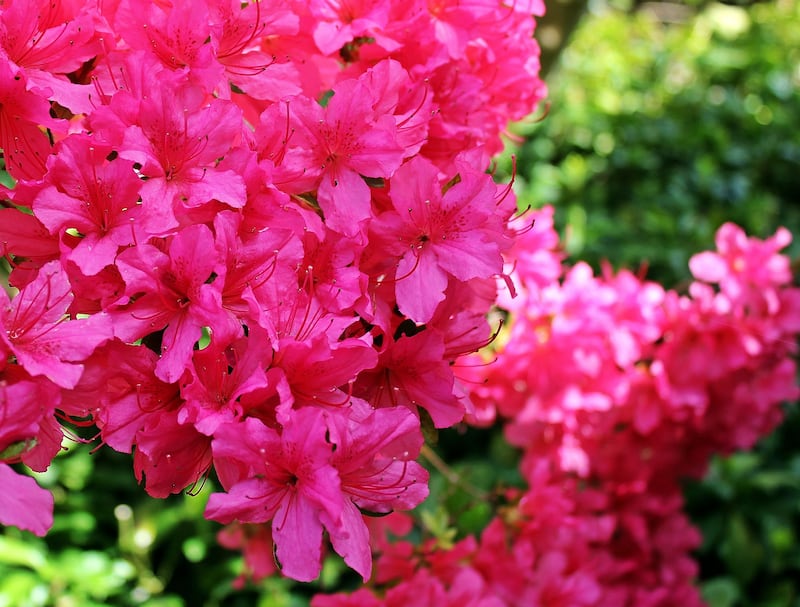
I know of only one flowering plant that will cause a traffic jam, and that plant is the azalea. Regardless of the location, whether it’s a narrow residential lane or a well-traveled thoroughfare, cars will be lining up in many Oklahoma communities this month to see the properties that have skillfully planted this marvelous spring-flowering evergreen shrub.
If you are a plant lover, I would imagine you have taken a drive or two into town to see the neighborhoods that are intensely planted with the cheerful azalea. Some of these special spots have showcased azaleas and other spring-flowering trees and shrubs for over 50 years, and the crowds keep coming!
How have they kept the plants healthy and happy for so long? What are the secrets to success with this princess of all flowering shrubs?
Some time ago I followed a long line of cars to just such a special neighborhood in Oklahoma City. Every home in the housing addition was adorned with beautiful mature azaleas. The intensity grew as we drove along, increasing in measure from one house to the next until ultimately we arrived at what appeared to be a gigantic block party. Literally, hundreds of people were in the front yard in apparent wonder over the number and size of the plants. They were everywhere and absolutely jaw-droppingly beautiful.
The owner of the house was Jack London, a retired nurseryman with a serious passion for azaleas. His yard, which he opened to the public each spring during the peak bloom, was home to six hundred specimens. Jack loved to share the secrets behind his success with azaleas to anyone who would listen, and I took advantage of his knowledge on numerous occasions over the next ten years as I had occasion to stop by.
It’s been thirty years since that first traffic jam on 16th Street between Rockwell and Council Road in Oklahoma City, but I still remember the tips and advice I received. Here are excerpts from some of my notes taken while visiting with Jack.
Location
First of all, azaleas bloom best when they get plenty of bright light in the morning and shade or filtered sun in the afternoon and evening. You could see the plants he had which received good sunshine in the morning and midday, they were much fuller with flowers than those in shadier spots.
Soil and Planting
Because azaleas die mostly from root rot, the result of poor drainage, it is critical that they are never placed in wet or poorly drained environments. The best way to establish a new plant, if the soil is poorly drained or a tight clay, is to set the root ball on the surface of a newly dug up bed and to mound a prepared blend of equal parts of pine bark, peat moss, and pecan hulls all around the plant roots. A wall or edging can hold the planting mix in the azalea bed. The planting bed needs to be 15″ to 18″ high or deep, depending upon your soil type.
Fertilizer
Jack suggested fertilizing azaleas around the time they are completing their bloom cycle. This way they will not form green shoots and leaves too early covering up the beautiful blossoms. Many azalea fertilizer products are available which are specially formulated to lower the pH of the soil and provide necessary micronutrients. Osmocote plant food is great for season-long feeding. Fall fertilizing is not recommended, but should leaves turn yellow, use a liquid iron product to satisfy this deficiency.
Pruning
London taught me how to prune an azalea properly by selectively removing branches that are too tall. The trick is following the tall branch all the way down into the shrub where it is connected to the next largest branch, and to cut it off flush. After several tall branches are removed the height of the shrub is diminished, and you could not tell that it had been touched! He warned to never shear an azalea and to sterilize the pruner between plants. Pruning after mid July will remove the buds formed for the next spring’s bloom, so try to accomplish all pruning before the end of June!
Mulching
Jack’s plan for mulching was simple. Every fall, when they became available in bulk quantities, he applied a 1 ½” layer of pecan hulls around his plants. In the early summer, he would reapply as needed. Pecan hulls are slow to decompose, allow water and air to freely enter the planting bed and tend to acidify the soil. Pine bark is also very desirable for mulch, and has been reported to reduce the incidence of root rot phytophthora fungus.
Plant Selection
Thousands of cultivated varieties of azaleas have been developed over the past 50 years. Outstanding hybrids for Oklahoma can be seen in bloom at Lendonwood Gardens in Grove, Honor Heights Park in Muskogee, Woodward Park and the Linnaeus Garden in Tulsa and the Dallas Arboretum in northeastern Dallas. The early development of azalea varieties goes back over 200 years with most deciduous types and varieties being hybridized and selected in England and Belgium, and evergreen types and varieties coming from Japan. A large number of deciduous azaleas are native to the eastern U.S., at least one species is native to Oklahoma. The primary deciduous types are Exbury, Ilam, Ghent, and Mollis azaleas. The primary evergreen types are the Indica, Kaempferi, Kurumi, and Satsuki azaleas. Strains of azalea have been developed by nurseries over the years which have been very good for our area. The very best for us is the Glen Dale Hybrids, hardy to -10 F, they are large and showy. Also very good for Oklahoma are the Girard Hybrids, they are hardy to -15 F. The Kurume Hybrids are probably the most sold types in the nursery trade, hardy to -8 F., mostly because they are compact and very beautiful in bloom. The Gable Hybrid varieties are also very nice for eastern Oklahoma, extremely cold and hardy, yet they do not hold up well in Oklahoma’s heat. A new type of deciduous azalea has been developed called the Aromi Hybrid deciduous azalea. It is much more able to withstand the hot summers here and has wonderful golden blooms.
The biggest difference between the true Rhododendron and the Azalea is the size of the leaves and bloom clusters. True Rhododendrons are native to southern China, eastern Pakistan, and northern India in the higher elevations. Because they are happier in cooler climates, we don’t have much success with them in Oklahoma. New cultivated varieties are on trial at the Lendonwood Gardens in Grove, Oklahoma that show promise for our area.
Here are the names of good azalea varieties for Oklahoma:
Early April Bloomers
- Hinodegiri - Cerise Pink
- Coral Bells - Hot Pink
- Snow - Early White
- Elsie Lee - Double Lavender
- Christmas Cheer - Earliest Bright Red
- Girard Hotshot - Bright Red-Orange, Compact
- Mother’s Day - Carmine Red
- Hampton Beauty - Dbl. White, Pink Red Edges
- Mildred Mae - Dbl. Flower, Reddish Purple
- Poukhanense - Large Lavender bloom, semi-deciduous
Mid-April Bloomers
- Hinocrimson - Bright Red
- Hershey Red - Dark Red, Double Flower
- Massasoit - Bright Brick Red
- Sherwood Red - Vivid Red-Orange
- Red Ruffles - Bright Red
- Pink Ruffles - Bright Pink, Tall
- Amy - Light Pink
- Nancy - Light Pink, dbl.
- Pink Pearl - Very Soft Pink
- Delaware Valley - White Large Flowers
- H.H. Hume - Pure White, Large flower
- Fashion - Salmon Pink
- Glory - Soft Salmon
- Herbert - Vivid Purple
- Girard ‘Pleasant’ - Dbl. White
- Girard ‘Crimson’ - Bright Red, Compact
- Girard ‘Fuschia’ - Dark Reddish Purple Dbl.
- Girard ‘Rose’ - Compact Bright Pink
- Girard ‘Scarlet’ - Deep Red Dbl.Flower
- Girard ‘Kathy’ - White Dbl., very hardy
- Girard ‘Christina’ - Dbl. Dark Pink
- Girard ‘Renee Michelle’ - Soft Pinkish Red
- Midnight Flare - Dark Red
Late Spring Bloomers
- Gumpo White - Dwarf White
- Gumpo Pink - Dwarf Soft Pink
- Rosebud - Bright Pink, highly dbl
Encore Azaleas
- Over 25 var. that bloom spring, summer, and fall!
Cox Media Group





